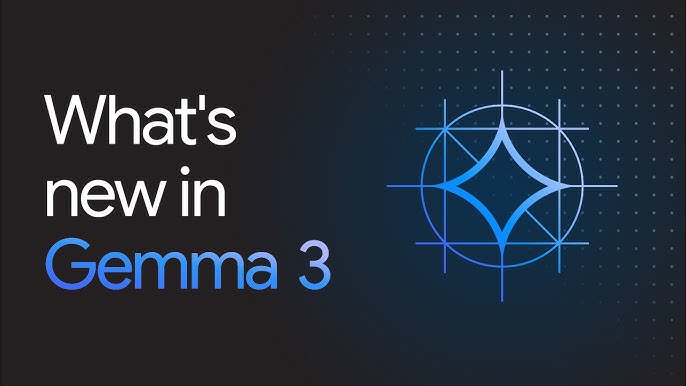Gemma 3: Google's Latest Breakthrough in AI
 Harshi Shah
Harshi Shah
Introduction
Google has once again pushed the boundaries of AI with Gemma 3, a powerful and efficient model designed for developers and researchers. With enhanced reasoning, extended context capabilities, and improved performance, Gemma 3 is poised to revolutionize how AI is integrated into applications.
In this blog, we’ll explore what makes Gemma 3 unique, its key features, and how it compares to other AI models.
What is Gemma 3?
Gemma 3 is Google's latest open-weight AI model, built for high performance and efficiency. It comes in multiple parameter sizes, making it versatile and suitable for a wide range of applications—from chatbots and virtual assistants to advanced reasoning tasks.
Key Features of Gemma 3
1. Multimodal Capabilities
Unlike its predecessors, Gemma 3 can process both text and images, making it a multimodal model. This allows it to:
Understand text-based inputs more contextually.
Analyze and generate images along with text.
Improve interaction in applications requiring visual and textual understanding.
2. Extended Context Window (128K Tokens)
One of the most significant upgrades in Gemma 3 is its 128,000-token context window. This is 16 times larger than previous models, allowing:
Better handling of long-form content like research papers, codebases, and novels.
More coherent and contextually aware responses.
Enhanced memory retention over extended conversations.
3. Multiple Model Sizes for Different Applications
Gemma 3 is available in various sizes, making it scalable for different computational needs:
1B parameters – Ideal for lightweight tasks and mobile devices.
4B parameters – Balances performance and efficiency for web applications.
12B parameters – Suitable for advanced AI applications.
27B parameters – The most powerful version for research and enterprise use.
4. Multilingual Support
Gemma 3 supports over 140 languages, making it a global AI model. This is beneficial for:
Cross-language translations and multilingual chatbots.
Creating AI tools that cater to diverse linguistic communities.
Expanding AI accessibility beyond English-speaking users.
5. Efficient Deployment
Unlike many AI models that require high-end GPUs, Gemma 3 is designed for efficient deployment:
It can run on single GPUs or TPUs.
The smaller versions (1B and 4B) can be deployed on mobile phones and laptops.
This reduces infrastructure costs and makes AI more accessible to developers.
6. Improved Reasoning and Coding Abilities
Gemma 3 excels in:
Mathematical reasoning (solving complex equations).
Coding and debugging (writing high-quality code with better accuracy).
Function calling (allowing developers to integrate AI with external tools easily).
Comparison: Gemma 3 vs. Other AI Models
| Features | Gemma 3 | GPT-4 | Llama 3 |
| Multimodal Support | ✅ Yes | ✅ Yes | ❌ No |
| Context Window | 128K tokens | 32K tokens | 64K tokens |
| Languages Supported | 140+ | ~50 | ~100 |
| Parameter Sizes | 1B, 4B, 12B, 27B | 8B, 30B | 7B, 13B, 70B |
| Runs on Single GPU? | ✅ Yes | ❌ No | ✅ Yes |
As seen in the comparison, Gemma 3 stands out with its extended context window, multilingual support, and efficiency.
Use Cases and Applications
With its powerful features, Gemma 3 is useful in various domains:
🔹 Chatbots and Virtual Assistants
More contextually aware and intelligent responses.
Improved customer service interactions with long-term memory.
🔹 Content Generation
Writing high-quality blogs, articles, and reports.
Creating multilingual content without losing accuracy.
🔹 Programming and Debugging
Assisting developers in writing and reviewing code.
Debugging and providing code optimization suggestions.
🔹 Education and Research
Generating summaries of research papers.
Assisting students in learning math, science, and languages.
🔹 Healthcare AI
Analyzing medical reports and providing preliminary assessments.
Supporting mental health AI chatbots for users seeking help.
Community and Developer Adoption
The AI community has responded positively to Gemma 3, especially due to:
Its high performance despite smaller sizes.
Open-source accessibility for research and development.
Compatibility with Google Cloud, Hugging Face, and on-device AI.
Many developers find the 1B and 4B models surprisingly powerful, making them useful for lightweight applications.
Conclusion
Gemma 3 is Google’s most advanced AI model yet, offering:
✔ Multimodal understanding (text & images).
✔ A massive 128K token context window.
✔ Multilingual capabilities across 140+ languages.
✔ Scalability across devices, from mobile to enterprise GPUs.
✔ Enhanced reasoning, coding, and knowledge retention.
With these advancements, Gemma 3 is set to reshape the AI landscape. Whether you're a developer, researcher, or AI enthusiast, it opens new possibilities for AI applications.
Subscribe to my newsletter
Read articles from Harshi Shah directly inside your inbox. Subscribe to the newsletter, and don't miss out.
Written by

Harshi Shah
Harshi Shah
Hey there! I'm a tech enthusiast, developer, and blogger who loves breaking down complex concepts into simple, digestible content. From coding tips to deep dives into the latest tech trends, I write to share knowledge and spark discussions. Passionate about web development, problem-solving, and lifelong learning. Let’s explore the tech world together—one blog at a time!